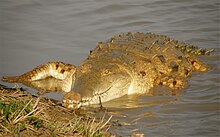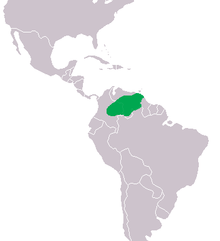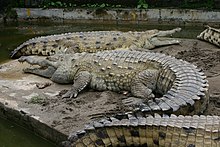Orinoco crocodile
| Orinoco crocodile | |
|---|---|

| |
| Orinoco crocodile in Los Llanos, Venezuela | |
| Scientific classification | |
| Domain: | Eukaryota |
| Kingdom: | Animalia |
| Phylum: | Chordata |
| Class: | Reptilia |
| Clade: | Archosauromorpha |
| Clade: | Archosauriformes |
| Order: | Crocodilia |
| Family: | Crocodylidae |
| Genus: | Crocodylus |
| Species: | C. intermedius
|
| Binomial name | |
| Crocodylus intermedius Graves, 1819
| |

| |
| Range (green) | |
The Orinoco crocodile (Crocodylus intermedius) is a
The biology of the Orinoco crocodile is poorly documented in the wild, mostly due to its small population. It is thought to have a more
Taxonomy
The
Below is a
| Crocodylinae |
| ||||||||||||||||||||||||||||||||||||||||||||||||||||||||||||||||||||||||||||||||||||||||||||||||
Characteristics

The Orinoco crocodile can be recognised by its relatively long snout, which is narrower than that of the somewhat similar-looking American crocodile. This species generally has a pale tan hide, though at least three coloration variations are known, with some almost completely yellowish, and some a dark brownish-gray. The skin can change colour over long periods of time; this phenomenon has been recorded in other species that can gradually change the amount of melanin in their skin. These crocodiles have dark-brown markings, which present as more pronounced bands in younger specimens and as scattered markings on mature ones.[7] One individual measuring 3.4 m (11 ft 2 in) and weighing 182 kg (401 lb) had a bite force of 6,276 N (1,411 lbf).[8]
Size

The Orinoco crocodile ranks among the
Distribution and habitat
This species is restricted to the
Behavior and ecology
Hunting and diet

Little study has gone into the dietary biology of Orinoco crocodiles but from eye-witness accounts and partial studies from captivity and crocodile farms, the majority of the Orinoco crocodile's diet appears to consists of large fish. The species' relatively narrow snout is ideally suited to minimize water resistance in capturing such aquatic prey. However, as an opportunistic apex predator, virtually any animal living within its range could be considered a potential meal, such as invertebrates,
Attacks on humans have been reported, but this is highly unlikely to be a common behavior today, given the very small population of the species and its relative isolation from large human settlements. Historically attacks were not unusual and on his trip to the region in 1800, natives told Alexander von Humboldt that two or three adult people were killed per year by Orinoco crocodiles.[21] A small number of better documented fatal attacks were reported in the 1900s–1930s when the species was still relatively common.[22] The only well-documented recent attack, on a fisherman in 2009, was serious but not fatal.[21][23] A second survivor was reported in 2011 to live in La Palmita at the Cojedes River, but any details of this attack (including when exactly it happened) are lacking.[21]
Reproduction

When water recedes in the
Conservation status

The Orinoco crocodile is highly endangered due to excessive hunting for its hide. During the 1940s to the 1960s, thousands of these animals were slaughtered in the Orinoco River and the Llanos wetlands, and the species came very close to extinction. The Orinoco crocodile was given protected status in the 1970s, but has yet to recover. Today, it is protected both in Colombia and Venezuela, and also included on Appendix I by CITES. In addition to hunting for its hide, more recent threats include the collection of juveniles for sale in the live animal trade, pollution, and the proposal of a dam in the upper Orinoco River region. Another problem is the increased population of spectacled caimans, a smaller crocodilian that can outcompete the Orinoco crocodile for fish due to its much larger population and much more accelerated breeding rates.[7]
It's unclear how many individuals remain in the wild, but estimates range between 250 and 1500.
In November 2007, 50 individuals were held in
The Orinoco crocodile became part of Proyecto Vida Silvestre, a program launched in 2014 to protect 10 wildlife species of Colombia's Llanos. Thanks to that program, between May 2015 and February 2016, 41 orinoco crocodiles were reintroduced at El Tuparro National Natural Park in eastern Colombia.[32]
References
- PMID 34567843.
- ^ a b Balaguera-Reina, S.A.; Espinosa-Blanco, A.; Antelo, R.; Morales-Betancourt, M. & Seijas, A. (2020) [errata version of 2018 assessment]. "Crocodylus intermedius". IUCN Red List of Threatened Species. 2018: e.T5661A181089024. Retrieved 22 January 2022.
- ISBN 978-0-19-066829-7.
- ^ PMID 33907305.
- S2CID 7254442.
- PMID 30051855.
- ^ a b c d e f g Ross, R.P. (1998) Crocodiles: Status Survey and Conservation Action Plan. Second Edition. IUCN/SSC Crocodile Specialist Group, IUCN, Gland, Switzerland and Cambridge, UK.
- PMID 22431965.
- ^ ISBN 978-0-85112-235-9.
- ^ JSTOR 1564821.
- PMID 5461083.
- ^ Gladys Porter Zoo (2011). "Critically Endangered Orinoco Crocodiles Coming to Gladys Porter Zoo". prnewswire.com.
- ^ Alvaro Velasco, B. (2023). "Journey of 7 Orinoco Crocodiles from Venezuela to Denmark" (PDF). Crocodile Specialist Group Newsletter. 42 (2). IUCN - Species Survival Commission: 8.
- ISBN 978-958-8343-87-7.)
{{cite book}}: CS1 maint: location missing publisher (link - JSTOR 1562913.
- ^ Whitaker, R.; Whitaker, N. (2008). "Who's got the biggest?" (PDF). Crocodile Specialist Group Newsletter. 27 (4): 26−30.
- ^ Merchán, M. (2011). Natural history and conservation of the Orinoco crocodile (Crocodylus intermedius Graves, 1819) in Colombia. Madrid: Asociación Chelonia.
- ^ "Crocodilian Species - Orinoco Crocodile (Crocodylus intermedius)".
- ^ Clarac, F., Souter, T., Cubo, J., De Buffrénil, V., Brochu, C., & Cornette, R. (2016). Does skull morphology constrain bone ornamentation? A morphometric analysis in the Crocodylia. Journal of Anatomy, 229(2), 292-301.
- ^ Gorzula, S., & Seijas, A. E. (1986). "The Common Caiman", p. 44 in Crocodiles: Proceedings of the 7th Working Meeting of the Crocodile Specialist Group of the Species Survival Commission of the International Union for Conservation of Nature and Natural Resources, Caracas, Venezuela, 21 to 28 October 1984. IUCN.
- ^ a b c Barrio-Amoros, C.L. (February 2011). "Orinoco Croc Encounters". Reptiles Magazine: 48–53.
- ^ CrocBITE, Worldwide Crocodilian Attack Database: Orinoco crocodile. Charles Darwin University, Northern Territory, Australia.
- ^ CrocBITE, Worldwide Crocodilian Attack Database: Orinoco crocodile, 15 June 2009. Charles Darwin University, Northern Territory, Australia.
- JSTOR 1564822.)
{{cite journal}}: CS1 maint: multiple names: authors list (link - ^ PMID 26982578.
- .
- ^ Blohm, T. (1982). "Husbandry of Orinoco crocodiles (Crocodylus intermedius) in Venezuela", pp. 267–285 in Crocodiles: Proceedings of the 5th Working Meeting of the Crocodile Specialist Group, IUCN–The World Conservation Union, Gland, Switzerland.
- ^ Information on Crocodylus intermedius. Archived 1 May 2006 at the Wayback Machine ARKIVE.
- ^ IUCN/SSC Crocodylus intermedius. Crocodile Specialist Group – Status Survey and Conservation Action Plan, 2nd edition.
- ^ "Captives held in zoos registered by ISIS". Archived from the original on 9 February 2008. Retrieved 9 November 2007.
- ^ "Venezuela's Fitful Effort to Save a Scaly Predator", The New York Times, 25 December 2013
- ^ Endangered Colombian crocodiles get a helping hand. Fox News (15 February 2016). Retrieved on 2019-01-25.

